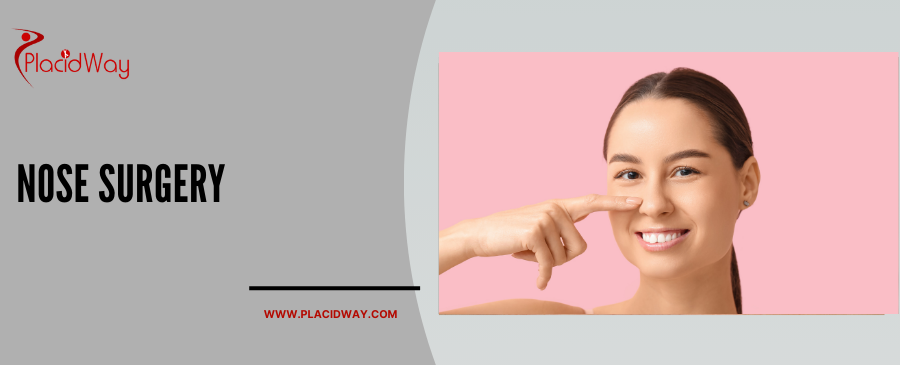
Considering Nose Surgery? Discover Your Path to Better Breathing & a Confident Profile
Your nose is more than just a facial feature; it's a vital pathway for breathing and a central element of your facial harmony. For many, concerns about their nose can range from persistent breathing difficulties to aesthetic dissatisfaction, impacting both quality of life and self-confidence. If you've ever found yourself wondering "can my nose be fixed?" or searching for "nose job cost" because of how your nose looks or feels, you're not alone.
Nose surgery, often referred to as rhinoplasty (for cosmetic enhancements) or septoplasty (for functional improvements), offers life-changing solutions. Whether you're struggling with a chronic stuffy nose, recurrent sinus infections, or simply wish for a more balanced facial appearance, modern nose surgery can address a wide array of issues.
But what if the ideal solution seems out of reach in your home country due to high costs or long wait times? This is where medical tourism comes into play. Thousands of patients each year discover the benefits of traveling abroad for nose surgery, accessing world-class care, experienced surgeons, and significant cost savings. This comprehensive guide will explore everything you need to know about nose surgery, from understanding its purpose and procedure types to navigating your options for treatment overseas.
We’ll delve into common symptoms, causes, the different types of "nose jobs," and what to expect during recovery. Crucially, we’ll also provide insights into the growing trend of "nose surgery abroad," highlighting why it's a compelling option for many, how to choose the right destination, and ensure a safe and successful experience. Your journey to better breathing and a confident profile starts here.
What are the common symptoms that indicate you might need nose surgery?
Many individuals consider nose surgery not just for aesthetics but out of necessity due to persistent health issues. Common symptoms suggesting a need for a "nose fix" include chronic nasal obstruction or a "blocked nose" sensation, especially on one side. This can lead to mouth breathing, snoring, and dry mouth. Recurrent sinus infections (chronic sinusitis) that don't respond to medication often point to structural problems within the nose. Frequent nosebleeds without a clear external cause can also be a red flag. From a cosmetic standpoint, visible asymmetry, a crooked nose, a prominent hump on the bridge, or a bulbous tip can significantly impact self-esteem and prompt a desire for reshaping. If you experience these symptoms, especially if they affect your daily life or sleep, it's worth exploring if nose surgery could offer relief.
What causes nasal problems that require surgical correction?
Nasal problems requiring surgery can originate from various sources. The most common structural issue is a deviated septum, where the wall between your nostrils is off-center, blocking airflow. This can be present from birth or result from a childhood injury that went unnoticed. Trauma, such as a sports injury or accident, can directly cause nasal fractures, leading to a crooked nose, breathing difficulties, or a collapsed bridge. Genetic factors also play a significant role in the natural shape and structure of the nose, influencing everything from the size of the nostrils to the projection of the tip. Additionally, conditions like enlarged turbinates (structures inside the nose that humidify air) can cause chronic congestion and require reduction for better airflow. Understanding the underlying cause is crucial for determining the most effective surgical approach.
What are the different types of nose surgery available?
When people talk about "nose surgery," they often refer to several distinct procedures. The most well-known is Rhinoplasty, commonly known as a "nose job," which is performed to change the shape, size, and overall appearance of the nose. This can involve reducing a hump, refining the tip, altering nostril size, or correcting asymmetry. For those experiencing breathing issues due to a deviated septum, Septoplasty is the surgical solution, focusing solely on straightening the septum without altering external appearance. Often, patients require both aesthetic and functional improvements, leading to a Septorhinoplasty, which combines both procedures. Other related procedures include turbinate reduction, which shrinks enlarged turbinates to improve airflow, and revision rhinoplasty, for those who've had previous nose surgery and seek further correction or improvement.
Who is a good candidate for nose surgery?
Determining eligibility for nose surgery involves several factors. Generally, candidates should be in good overall health, without serious medical conditions that could complicate surgery or recovery. For cosmetic rhinoplasty, it's crucial that the patient's nasal bones are fully developed, typically around 15-16 for girls and 16-17 for boys. This ensures stable, long-lasting results. Psychological readiness is also key; candidates should have realistic expectations about what surgery can achieve and understand the potential outcomes. They should be able to articulate their concerns clearly, whether they are focused on breathing improvement or aesthetic changes to their "nose shape." A consultation with a qualified surgeon will involve a thorough examination of your nasal structure, medical history review, and a discussion of your goals to determine if you are a suitable candidate.
What is the typical recovery time and what should I expect after nose surgery?
Recovery from nose surgery varies depending on the extent of the procedure, but a general timeline can be expected. Immediately after surgery, you'll likely have a splint or cast on your nose, and possibly packing inside, to support the new structure. You can expect noticeable swelling and bruising around the eyes and nose for the first week to ten days, which gradually subsides. Most patients can return to light activities and work within 7-10 days, once the splint is removed. Strenuous exercise should be avoided for 3-6 weeks. While much of the initial swelling diminishes quickly, subtle swelling can persist for up to a year or even longer, particularly in the nasal tip. It's important to follow all post-operative instructions carefully, including avoiding glasses if possible, sleeping with your head elevated, and protecting your nose from any impact to ensure optimal "rhinoplasty recovery" and results.
What are the potential risks and side effects of nose surgery?
Like any surgical procedure, nose surgery carries potential risks and side effects, though serious complications are rare. Common, temporary side effects include swelling, bruising, and mild discomfort. More significant but less common risks include infection, excessive bleeding, adverse reactions to anesthesia, and persistent numbness or changes in sensation in or around the nose. Some patients may experience minor breathing difficulties post-surgery, which usually resolve as swelling subsides. In rare cases, a small perforation of the septum (a hole) can occur, which might require further repair. A key concern for many is dissatisfaction with the aesthetic outcome, leading to the desire for a "revision rhinoplasty." Choosing a highly experienced and board-certified surgeon significantly minimizes these risks and increases the likelihood of a successful result.
How does the cost of nose surgery vary globally?
The cost of nose surgery, whether it's rhinoplasty or septoplasty, can differ dramatically from one country to another. These variations are influenced by factors such as the country's cost of living, surgeon's fees, facility charges, anesthesia costs, and the complexity of the procedure. For example, a "nose job cost" in Western countries like the USA or UK can range from $6,000 to upwards of $15,000 or even $20,000 for complex cases. In contrast, destinations renowned for medical tourism offer significantly more competitive pricing without compromising on quality.
Here’s a general overview of average costs:
| Country | Average Cost Range (USD) | Typical Inclusions |
|---|---|---|
| USA / Canada | $6,000 - $15,000+ | Surgeon's fee, anesthesia, facility fee (often excludes pre/post-op care). |
| UK / Western Europe | $5,000 - $12,000+ | Surgeon's fee, hospital, anesthesia (may have limited aftercare). |
| Turkey | $3,000 - $7,000 | All-inclusive packages often including accommodation, transfers, consultation, surgery, and aftercare. |
| India | $2,500 - $6,000 | Comprehensive packages, sometimes including local travel and accommodation. |
| Mexico | $3,500 - $7,500 | Often includes surgeon's fees, facility costs, and some post-op care. |
| South Korea | $4,000 - $9,000 | Known for highly specialized clinics, packages vary but often include translation services. |
*Costs are estimates and can vary based on surgeon experience, clinic reputation, procedure complexity, and inclusions.
Why should I consider traveling abroad for nose surgery?
The decision to seek "nose surgery abroad" is often driven by compelling advantages. Foremost among these is the dramatic cost savings. For many, the high price tag in their home country makes procedures like rhinoplasty or septoplasty unaffordable. Medical tourism destinations offer the same, if not superior, quality of care at a fraction of the cost, often including travel and accommodation in all-inclusive packages. Beyond cost, patients can access world-renowned surgeons who specialize in particular types of nose surgery, sometimes with more extensive experience in specific techniques than local practitioners. Shorter waiting lists are another major draw, allowing patients to schedule their procedure without long delays. Finally, the privacy of recovering in a foreign country, away from familiar routines and curious eyes, appeals to many seeking a discreet transformation.
Which countries offer the best value and quality for nose surgery abroad?
Several countries have emerged as global leaders in medical tourism for nose surgery, balancing affordability with high-quality care. Turkey is a prime example, particularly Istanbul, known for its highly skilled plastic surgeons, state-of-the-art clinics, and all-inclusive "rhinoplasty packages" that attract patients worldwide. South Korea is renowned for its advanced cosmetic surgery techniques, especially for Asian rhinoplasty, and offers cutting-edge technology. Mexico, particularly cities close to the US border, provides convenient access for North Americans seeking affordable yet excellent care. India boasts internationally accredited hospitals and experienced surgeons at very competitive prices, making it a strong contender for various procedures, including septoplasty and rhinoplasty. Poland and other Eastern European countries are also gaining popularity for their high standards of care and lower costs compared to Western Europe. When evaluating destinations, consider not just cost, but also surgeon credentials, facility accreditations, and patient reviews.
How can I ensure safety and quality when choosing a clinic for nose surgery abroad?
Ensuring safety and quality is paramount when considering "nose surgery overseas." The first step is to thoroughly vet your surgeon: look for board certifications, extensive experience specifically in rhinoplasty and septoplasty, and membership in reputable surgical associations. Clinics should ideally have international accreditations like Joint Commission International (JCI), which signifies adherence to global healthcare standards. Don't underestimate the power of patient testimonials and before-and-after photos, which offer insights into a surgeon's results and patient satisfaction. Communication is key; ensure the clinic provides clear information, speaks your language (or offers translation services), and addresses all your questions. Utilizing a reputable medical tourism facilitator like PlacidWay can greatly simplify this process, as they pre-screen clinics and surgeons, help with travel logistics, and provide transparent information, acting as a crucial advocate for your safety and successful outcome.
Take the Next Step with PlacidWay
Ready to explore treatment options abroad? Discover top clinics, compare prices, and get a free quote tailored to your needs with PlacidWay.










Share this listing